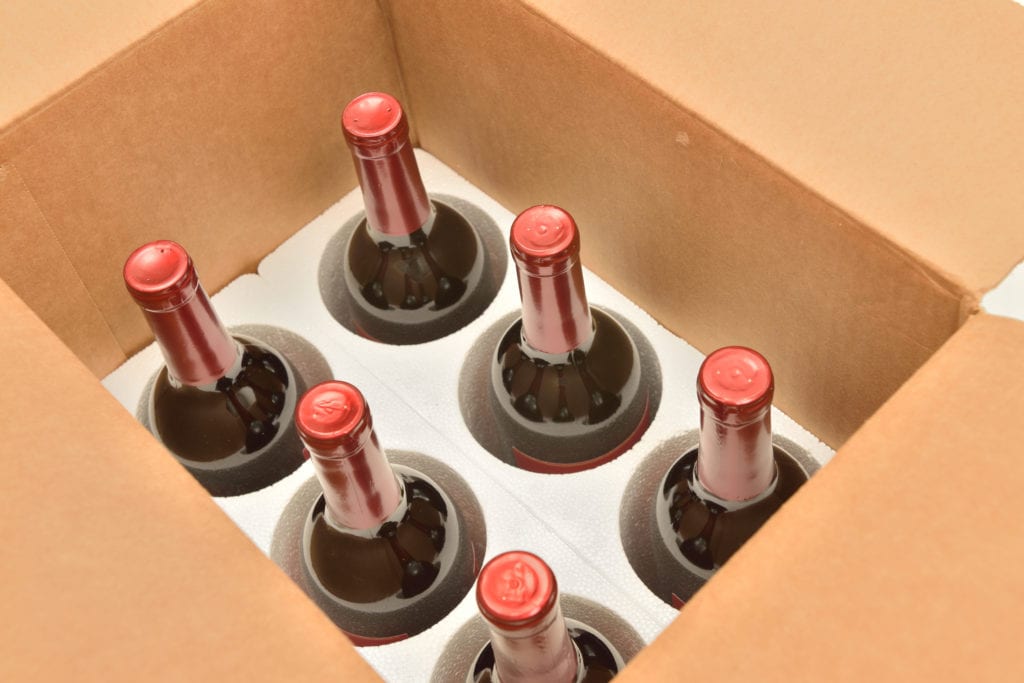Last Updated on June 25, 2021 by
Even as eCommerce is taking over most industries, wineries tend to lag behind. According to the 2019 State of the Wine Industry Report by Silicon Valley Bank, only about 8% of total wine sales direct to the consumer occur online. Total wine sales are even lower, as low as 4% according to some estimates. That puts the United States squarely behind other countries like France of the UK, which come closer to 20% respectively.
The reasons for that lag range widely. Shipping tends to be one of them. While a few states forbid the interstate shipments of wine, the 45 states that do allow it represent 94% of the entire U.S. population. These numbers show that although the actual problem is relatively minimal, resistance to buying wine online does exist.
Put simply, making an online wine purchase just doesn’t tend to seem natural to a relatively traditional audience that likes to taste it first. While that is beginning to shift as audiences are becoming younger, significant educational gaps still exist that can make establishing a successful eCommerce wine business difficult.
Of course, difficult is far from meaning impossible. If these educational gaps are intangible, they can be changed by savvy businesses who understand them and know how to solve them.
Most often, we see 5 pain points of potential customers that keep them from buying wine online. In this article, we’ll outline exactly what those educational gaps are, and how your website and digital marketing can mitigate them to build a more successful eCommerce presence.
Educational Gap 1: The Lack of Ability to Taste
According to the 2019 State of the Wine Industry Report, the tasting room accounts for the majority of revenue across wineries. There’s a reason that’s the case. Tastings turn the purchase into an experience, often lived through socially during special events or wine tours.
On a more basic level, tasting is crucial for many consumers because it allows them to make sure they like the wine before they buy the whole bottle. As any winery knows, no two types taste the same. Only tasting them can ensure confidence in the purchase.
The concern with eCommerce wine purchases is natural. If consumers don’t know what the wine tastes like, how can they reliably make a choice that works for them? And, on an even more basic level, how can they make sure that winery they’re trying out for the first time actually produces a quality vintage.
This is how we arrive at our first educational gap. The lack of ability to taste a wine before buying it leaves many customers wondering whether the online route is viable at all. Of course, it can be, as long as the right messaging and reassurance is in place.
To Close The Taste Gap: Embrace Social Proof
Social proof is important across industries, tapping into our basic psychological desire to get reassurance from our peers and experts alike. It’s difficult to imagine an industry where this concept matters more than online wine sales.
Wine tasting is essentially a social experience. Social proof approximates that experience in the online environment. That can happen in a number of ways:
- Ratings of your individual bottles that show their overall quality.
- Quotes and testimonials from customers within your target audience.
- Expert reviews of your vintages (if available).
- Tasting profiles, established through customers who describe their experience with your wine.
This social proof will be most important on your product and checkout pages, where customers are most likely to hesitate because of their lack of ability to taste the wine. But it can also live on social media and elsewhere on your website and in your digital marketing.

Educational Gap 2: The Shipping Concerns
As mentioned in the introduction, shipping can be a real issue in wine eCommerce. In some states, it’s completely illegal to ship across state lines. But even where it is, you might run into consumer concerns that originate from simple educational gaps.
For instance, many would-be customers fear that the shipping process leads to damage to the bottle. Drastic shifts in temperature alone can be enough to significantly change the taste of even the greatest vino. And of course, a broken bottle will do no one any good.
These fears tend to be especially prevalent among more knowledgable audiences who understand the dangers of temperature changes. But even beyond those experts, the general fear of shipping fragile items rings true in the wine industry, as well.
To Close The Shipping Gap: Offer Assurance (and Insurance)
It’s difficult to educate your audience on anything that seems counterintuitive at first. Yes, fragile items can be difficult to ship, and wine bottles are naturally fragile. Still, you can take significant steps to offer your would-be customers the assurance they need to make that purchase.
The key here is showing, not telling your audience what they can expect. A few common steps to accomplish that feat include:
- Statistics on customer satisfaction or lack of complaints. If you can show that your customers are happy when they get the wine, chances are the shipping didn’t negatively influence it.
- A showcase of the shipping process. A quick video on your website or checkout page that shows exactly how you package the wine to keep it safe can go a long way.
- Satisfaction and shipping guarantees. Make sure your audience knows what they get if a bottle does break. That way, they know they won’t be left on their own for something that’s out of their control.
Concerns over shipping exist across eCommerce, but especially with perishable and fragile goods like wine. Consistent and honest assurance is key to overcoming your audience’s fears in this area and maximizing your online revenue potential.
Educational Gap 3: The Fear of Commitment
Almost everything you can buy online seems to be a subscription these days. That makes sense from a marketing perspective; by locking your audience into a long-term engagement, you maximize their lifetime value to your company and revenue. For your audience, though, it can be a problem.
Put simply, your audience is beginning to have subscription fatigue. They don’t necessarily want to commit, especially not to a new winery they don’t know much about. And yet, most wineries offer precisely that; subscription services (like online wine clubs) that require regular fees to be a part of.
Here, we arrive at another educational gap: the idea that to buy wine online, you have to commit to your winery of choice and get the same things, all the time. That might be true for some wineries, but it’s on you to educate your audience that it’s not actually the case. As long as you offer single purchases without any long-term commitment, it pays to communicate that to avoid this fear of commitment.
To Close The Commitment Gap: Be Bold in Your Offers
The first note is obvious: you need to tell your audience that to purchase a bottle of wine from you, they don’t have to commit. Just how you do that, of course, can be more complicated.
A few strategies in your digital marketing and web content can get you started:
- Update your copy; the words ‘no commitment’ by themselves may not be enough, but they can be a great start to alleviate concerns.
- Minimize the investment for new customers. While you cannot offer free shipping on purchases of alcohol, you can minimize friction by stating that shipping is included in the overall purchase price.
- Clearly distinguish any wine club or subscription plans you have from your regular product pages to clarify the difference.
- Avoid the ‘automatic renewal’ trap. Consumers are becoming wise to it and will tend to stay away. Instead, make renewal optional on anything beyond the first purchase.

Educational Gap 4: The Minimum Purchase Expectation
Closely related to the commitment gap is the fact that most consumers will expect a minimum purchase threshold from your winery. Even those that understand safe shipping will realize that these shipping methods tend to be expensive, making purchases of multiple bottles necessary to make up the difference.
Do you really want to try a bottle of wine if you have to buy a case just to get to it? The answer should be fairly obvious. At that point, purchasing a wine seems like a gamble. Nobody wants to end up with 6 or even 12 bottles of a taste they don’t especially like.
As a result, many consumers never even take the time to look further into eCommerce when it comes to their favorite drink, thinking that the investment will simply be too much to make this one-time commitment. It just seems so much easier to visit a wine room or a local store and buy a single bottle.
To Close The Minimum Purchase Gap: Offer Low-Quantity Packages
Similar to the commitment gap, the solution here is obvious at first glance but comes with some communication challenges. Closing the educational gap on minimum purchase expectations means simply offering your wine at the single bottle level instead of large packages. Of course, that can be easier said than done; shipping wine continues to be expensive, and you have to make sure that your online business is profitable.
That step, of course, goes beyond simple marketing and promotion. You may decide that your customer return rate is high enough that selling a single bottle to first-time, even if not profitable in its own right, will still result in positive returns thanks to its positive effect on customer lifetime value. Alternatively, you may find the quantity point at which the sale becomes profitable (such as 2 or 3 bottles), and use that as your minimum quantity.
With more expensive wines, where the shipping takes on a lower proportion of overall price, offering single bottles tends to be more straightforward. But even in that case, communication is a vital piece of making sure that your audience actually knows they can buy the bottle.
Here, your marketing content has to be absolutely clear. It should outline exactly what your minimum purchase quantity is, and how your audience can make sure they only go as long as they want to initially. Honesty pays off; the more you can reduce the discrepancy between expectations and reality, the less likely you will be to suffer cart abandonment.
Educational Gap 5: The Added Value Concern
Finally, your audience may wonder what, exactly they will get out of buying a bottle of wine online. After all, they will not experience the same or even an approximation of the feeling they get in that tasting room or reading the label in a store. The experience is more impersonal so what, exactly, is that added value?
It certainly isn’t tasting the wine. As established above, that is a sales barrier in general, but matters in the overall experience as well. Simply put, your audience misses that feeling of something that leads up to the actual purchase, someone that directly connects them to the bottle they’re about to own (and eventually drink).
To Close the Added Value Gap: Provide High-Quality Content
This barrier does not have an easy solution. Customers who miss the in-person experience of a wine sale aren’t wrong about online alternatives not being able to quite approach that level. What you can do, though, is find other ways in which you can provide added value to your customers through your website and digital marketing:
- Establish a community of wine lovers that can talk to each other about their favorite vintages and new bottles to try. Social media can be a great channel for that community.
- Provide content that goes above and beyond the actual wine sale. That might include a tasting guide for when the shipment arrives or recommendations on how to pair the wine for maximum benefit.
- Behind-the-scenes content from your winery shared on your website and social media, that provide insights into the process of going from grape to glass.
Is Your Winery Prepared for the Coming Online Boom?
The barriers to online wine shopping are real, mostly because consumer concerns are real. But that doesn’t mean they’re impossible to overcome. By closing these five educational gaps, you can leverage your digital presence to make your audience more confident in their online wine purchase.
The time to take action is now. While wine sales online are still relatively low, they’re expected to rise significantly in the next few years. As more customers are flocking into the digital space, wineries who can effectively communicate across these barriers have a greater chance of building online equity and loyalty.
That means having a comprehensive digital marketing infrastructure in place, allowing you to effectively add value and address consumer concerns. For help in that regard, contact us. Let’s work together to maximize your opportunities in the business of eCommerce wine sales.
